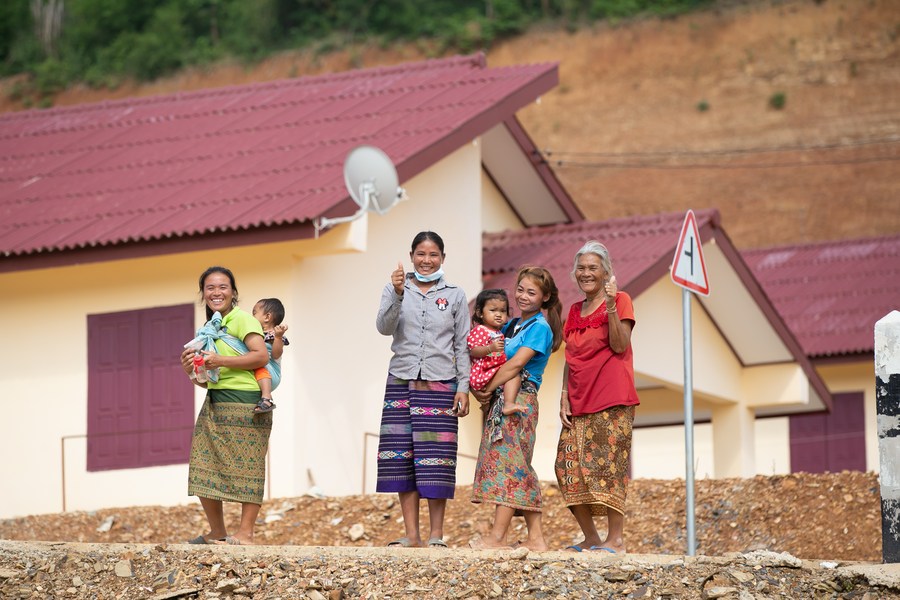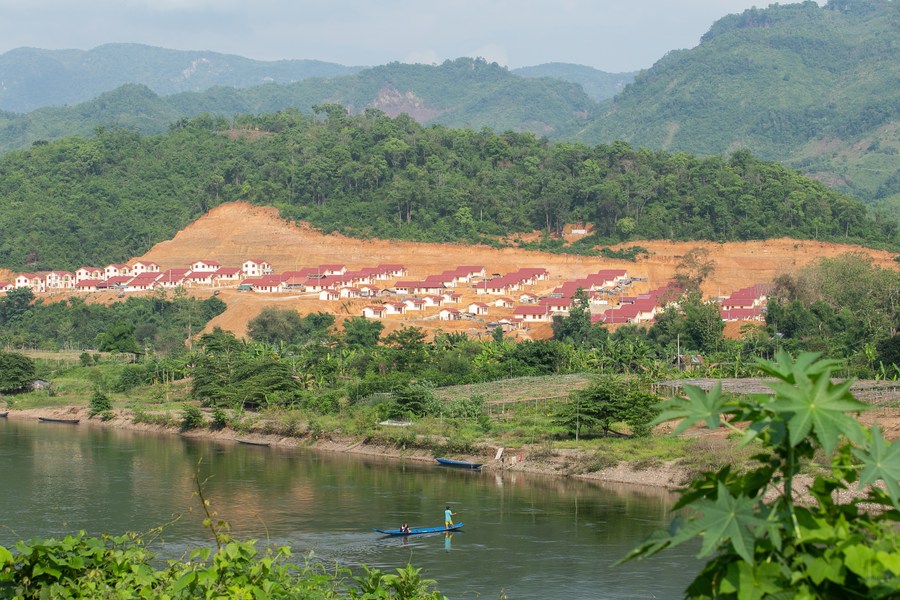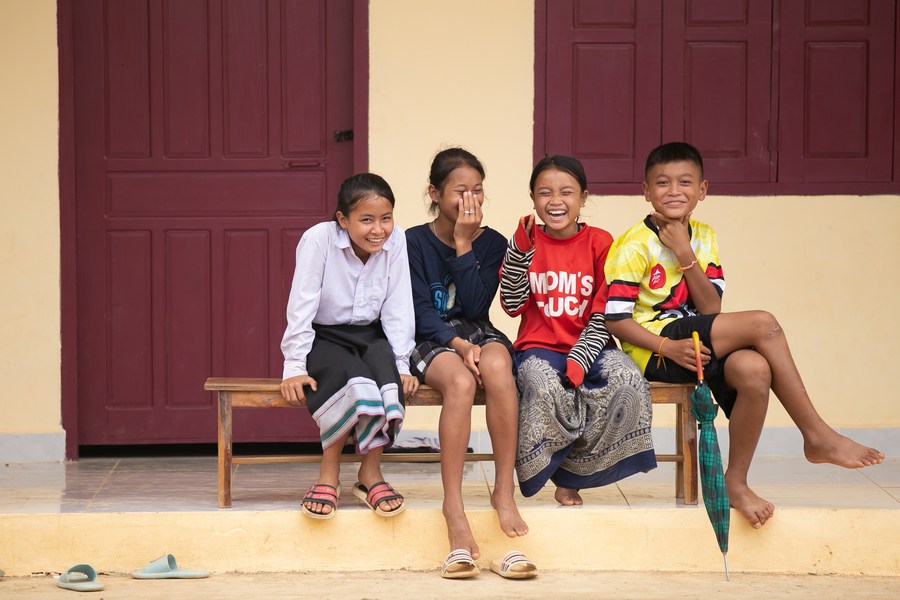Railway-resettled villagers move into new homes with new hopes
 Residents stand in front of their new houses in Buam Aor village, Xiang Ngeun district of Luang Prabang province, Laos, April 22, 2022. (Photo by Kaikeo Saiyasane/Xinhua)
Residents stand in front of their new houses in Buam Aor village, Xiang Ngeun district of Luang Prabang province, Laos, April 22, 2022. (Photo by Kaikeo Saiyasane/Xinhua)
The China-aided Buam Aor Resettlement Village Project in Laos is expected to greatly improve local infrastructure, education, medical care and living conditions, and help promote local economic development.
by Chanthaphaphone Mixayboua, Zhang Jianhua
The Lao villagers resettled for the construction of the China-Laos Railway are moving into new houses built with China's aid.
A ceremony on the resettlement and a calligraphy and drawing competition themed "For Shared Future" was held on Friday in Buam Aor village, Xiang Ngeun district of Luang Prabang province, some 220 km north of the Lao capital Vientiane, where a Chinese firm, NORINCO International Cooperation Ltd., has built a resettlement village for the construction of the China-Laos Railway.
 Photo taken on April 22, 2022 shows Buam Aor village in Xiang Ngeun district of Luang Prabang province, Laos. (Photo by Kaikeo Saiyasane/Xinhua)
Photo taken on April 22, 2022 shows Buam Aor village in Xiang Ngeun district of Luang Prabang province, Laos. (Photo by Kaikeo Saiyasane/Xinhua)
The China-aided railway relocation settlement in Buam Aor village, with neatly arranged residential buildings with red roofs and yellow walls, sits between lucid waters and lush mountains. The local residents have been busy moving into their new homes.
"We have new houses, new schools, new roads. This is what the Chinese engineers have built for us," Chandy Chittakone, a grade-five pupil read her composition at the ceremony in a newly-built school located along the Mekong River.
Lao Minister of Public Works and Transport Viengsavath Siphandone and Chinese Consul General in Luang Prabang Li Zhigong, among others, attended Friday's activity.
Before the ceremony, NORINCO International donated tables, chairs and stationeries to the school. Chinese teachers had taught pupils traditional Chinese calligraphy and drawing skills, with a competition held and an exhibition displaying the artworks of the pupils.
"In the calligraphy and painting competition, the children expressed their love for the Laos-China Railway, the natural environment and the new Buam Aor village," said Philavan Simdavong, a 29-year-old kindergarten teacher.
The Lao minister said that the success of the Buam Aor Resettlement Village Project has brought well-being to the village, noting that it is a high-standard, sustainable project, and brings a huge benefit for people's livelihood.
 Photo taken on April 22, 2022 shows residential buildings in Buam Aor village, Xiang Ngeun district of Luang Prabang province, Laos. (Photo by Kaikeo Saiyasane/Xinhua)
Photo taken on April 22, 2022 shows residential buildings in Buam Aor village, Xiang Ngeun district of Luang Prabang province, Laos. (Photo by Kaikeo Saiyasane/Xinhua)
Laos and China are friendly neighbors with a shared future, while the children are the future of the country and the relationship, and their calligraphy and drawings reflect the profound friendship between the two peoples, said Viengsavath.
"I'm very happy to find that the residents who have been resettled and relocated are now enjoying a happy life. The Buam Aor Resettlement Village Project is not only a good project to improve the people's livelihood, but also another vivid manifestation of the profound friendship between China and Laos," Chief Representative of the Buam Aor Project Jin Guofeng said.
Jin expressed hope that the project, with 107 resettled houses for 459 villagers, and the newly built village office, clinic, kindergarten and primary school, will greatly improve local infrastructure, education, medical care and living conditions, and help promote local economic development.
During the ceremony, Jin handed over a key symbolizing the new settlement to Viengsavath and a friendship tree was also planted by the Lao minister and the Chinese consul general.
 Children sit in front of a new house in Buam Aor village, Xiang Ngeun district of Luang Prabang province, Laos, April 22, 2022. (Photo by Kaikeo Saiyasane/Xinhua)
Children sit in front of a new house in Buam Aor village, Xiang Ngeun district of Luang Prabang province, Laos, April 22, 2022. (Photo by Kaikeo Saiyasane/Xinhua)
Li said at the ceremony that the China-Laos Railway, which has been completed and put into operation last December, is "injecting new impetus into Laos's economic development and improvement of people's livelihood."
Thongvan Vatthanaphone, the 43-year-old village chief, told Xinhua that in the past, some villagers had to live in grass huts, but now, their cement houses are very strong and much better.
"Now the railway passes through our hometown, and the railway connects Vientiane to China. Then the goods can be easily transported to other places (from Laos)," said the village chief.
Philavan, the kindergarten teacher, said "I hope that the children here will be able to take the train to Beijing, to study or travel when they grow up."